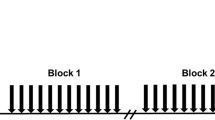Abstract
The aim of this study was to determine whether muscle fibre degeneration brought about by chronic lowfrequency electrical stimulation was related to the pattern and frequency of stimulation. Rabbit fast-twitch muscles, tibialis anterior and extensor digitorum longus, were stimulated for 9 days with pulse trains ranging in frequency from 1.25 Hz to 10 Hz. Histological data from these muscles were analysed with multivariate statistical techniques. At the lower stimulation frequencies there was a significantly lower incidence of degenerating muscle fibres. Fibres that reacted positively with an antineonatal antibody were most numerous in the sections that revealed the most degeneration. The dependence on frequency was generally similar for the two muscles, but the extensor digitorum longus muscles showed more degeneration than the tibialis anterior at every frequency. Muscles subjected to 10 Hz intermittent stimulation showed significantly less degeneration than muscles stimulated with 5 Hz continuously, although the aggregate number of impulses delivered was the same. The incidence of degeneration in the extensor digitorum longus muscles stimulated at 1.25 Hz was indistinguishable from that in control, unstimulated muscles; for the tibialis anterior muscles, this was also true for stimulation at 2.5 Hz. We conclude that damage is not an inevitable consequence of electrical stimulation. The influence of pattern and frequency on damage should be taken into account when devising neuromuscular stimulation régimes for clinical use.
Similar content being viewed by others
References
Acker MA, Hammond RL, Mannion JD, Salmons S, Stephenson LW (1987) Skeletal muscle as the potential power source for a cardiovascular pump: assessment in vivo. Science 236:324–327
Brown JMC, Henriksson J, Salmons S (1989) Restoration of fast muscle characteristics following cessation of chronic stimulation in the rabbit: physiological, histochemical and metabolic changes during slow-to fast transformation. Proc R Soc Lond [Biol] 235:321–346
Dubowitz (1985) Muscle biopsy. A practical approach, 2nd edn. Baillière Tindall, London
Hagege AA, Desnos M, Chachques JC, Carpentier A, Fernandez F, Fontaliran F, Guerot C (1990) Preliminary report: follow-up after dynamic cardiomyoplasty. Lancet 1122–1124
Jarvis JC, Salmons S (1991) A family of neuromuscular stimulators with optical transcutaneous control. J Med Eng Technol 15:53–57
Lexell J, Jarvis J, Downham D, Salmons S (1992) Quantitative morphology of stimulation-induced damage in rabbit fast-twitch skeletal muscles. Cell Tissue Res 269:195–204
Pette D, Vrbová G (1985) Neural control of phenotypic expression in mammalian muscle fibers. Muscle Nerve 8:676–689
Pette D Smith ME, Standte HW, Vrbová G (1973) Effects of long-term electrical stimulation on some contractile and metabolic characteristics of fast rabbit muscle. Pflügers Archiv 338:257–272
Salmons S, Henriksson J (1981) The adaptive response of skeletal muscle to increased use. Muscle Nerve 4:94–105
Salmons S, Jarvis JC (eds) (1991a) Harnessing skeletal muscle power for cardiac assistance. Proceedings of the Expert Meeting under EC Concerted Action “HEART” Commission of the European Communities
Salmons S, Jarvis JC (1991b) A simple optical switch for implantable devices. Med Biol Eng Comput 29:554–556
Seedorf K, Seedorf U, Pette D (1983) Coordinate expression of alkali and DTNB myosin light chains during transformation of rabbit fast muscle by chronic stimulation. FEBS Lett 158:321–324
Williams NS, Hallan RI, Koeze DH, Watkins ES (1989) Construction of a neorectum and a neonatal sphincter following previous proctolectomy. Brit J Surg 76:1191–1194
Author information
Authors and Affiliations
Rights and permissions
About this article
Cite this article
Lexell, J., Jarvis, J., Downham, D. et al. Stimulation-induced damage in rabbit fast-twitch skeletal muscles: a quantitative morphological study of the influence of pattern and frequency. Cell Tissue Res 273, 357–362 (1993). https://doi.org/10.1007/BF00312838
Received:
Accepted:
Issue Date:
DOI: https://doi.org/10.1007/BF00312838




